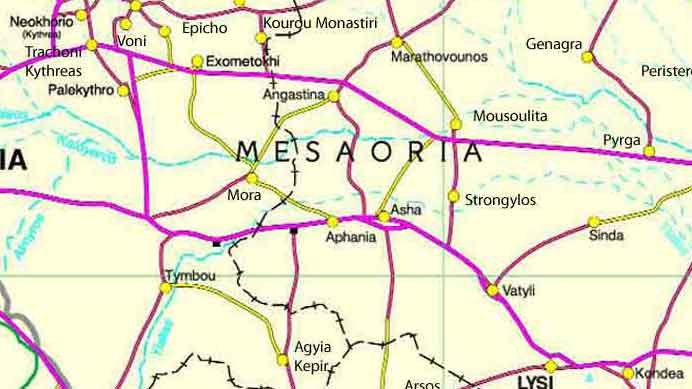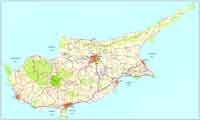.

Marathovounos (Greek : Μαραθόβουνος ) is a community of the District of Famagusta in the region of Cyprus occupied by the Turkish army.
It is named after fennel (Marathos) an aromatic and flavourful herb used in cooking and folk medicine. It was after the 1974 Turkish invasion that it was renamed Ulukışla, meaning “holy barracks” or “large barracks” in Turkish. Marathovounos is 2 kms north of the village of Angastina,4 kms south of the village of Tziados and 39 kms from its provincial capital Famagusta, to the east. It is 65 meters above sea level.[1]
Marathovounos was built on a hillock called Vounos (Greek for hill) on the northern edge of the Massaoria plain. Evidence of mid to late Bronze age habitation was discovered there. There's also an ancient Basilica at nearby Petrera. [2] There is speculation that there was an earlier Christian village at Vouno with a small church that dates from the 1700's. It is possible that one of the walls of Prophitis Ilias (Prophet Elias) , the church of Marathovounos, incorporated an old fresco from this small church.
In the early 1820s Greek Cypriots found refuge in the caves around the hillock of Vouno from Agia Paraskevi a nearby village to the north which had been established in 1571.[3] This was after a wave of massacres that were inflicted on the Greek Cypriots throughout the island by the Ottoman administrators who feared that there would be a similar uprising for independence as it occurred in Greece in 1821.[4][5] After this event Agia Paraskevi was renamed Tsiados and only Turks lived there. [6]
What remains of the Chapel of Timios Stauvros which is attached to the Greek Orthodox cemetery of Marathovounos, Cyprus. Note the cemetery headstones which were scrapped up and dumped within its walls.
| Year | Population |
| 1946 | 1789 |
| 1960 | 2020 |
| 1982 | |
| 1992 | |
| 2001 |
Between Marathovounos and Tsiados exists the exoklisi (outer chapel) of Timiou Stauvrou (Honourable Cross) at the location of the cemetery of Marathovounos. Since the invasion a digger has flattened the cemetery and the rubble has been deposited within the fallen walls of the old chapel. [7]
The headstone of Marika (surname broken off) in the Timios Stauvros Cemetary in Marathovounos, Cyprus 2012.
The main income of Marathovounos’ was from agriculture through the growth of wheat and barley and the farming of sheep and cattle. Men from the village worked in the mines on the Troodos massif and both women and men would travel to Famagusta or Nicosia to work in a variety of industries. They did this by catching the train which was first operated in 1905.[8] However this service was closed in 1951 as it became uneconomic with the arrival of buses and trucks. The station was about 2kms south east of the village.[9] A rural Police station was established in Marathovounos in 1905.[10]
In 1831 Marathovounos was recorded to have 138 inhabitants who were Greeks. Between the 1891 and the 1931 census not more than 5 Turks lived in the village. When Cyprus gained its independence in 1960 its inhabitants were 2019 Greeks. Before the invasion by Turkey in 1974, 2363 Greeks lived there but were driven out by the advancing Turkish army. In 1978 the Turkish population was recorded by the occupational administration as 311 but this total did not include women.[11]
Marathovounos viwed from the norther Tziados approach to the village. Note the post 1974 new Mosque on the left and the remains of the Church of Profitis Ilias on the right.
A primary school in Marathovounos was first established in 1869. The first teacher appointed to the village was Evgrafos Evstratiou. In 1974 during the 1973-74 school year 330 students were attending the school.[12]
Marathovounos boasted the only outdoor cinema for many years in the district until one was established in Angastina in the late 1950s.
In 1976 and 1977 Turkish families immigrated from the Kozan and Feke districts of the Adana region of Turkey. Among them are a few Turkish Cypriots. The 2006 census puts Marathovounos’ population at 876.[13]
Famous Marathovoniotes
People from Marathovounos who have found international fame include the modern painter Christophoros Sava (1924-1968)[14] and the current Archibishop of Thyateira and Great Britain, Gregorios.[15] Of local renown is the folk poet Georgios Panatsias known as Kogkonias (Γεώργιος Πανατσιάς Κογκονιάς) (1883-1963) and the poet and musician Michael Hatzimike.
References
^ Goodwin, Jack C. Tziados - the origins of the village name "is somewhat obscure, but there is a place in Tinos (a Greek Island) with this name, but as Tjiatos. Further Pilavakis mentions Chatos as a home of the Zen family, who came from Greece and used the surname Tjados." " The present village dates back to the early Middle Ages at least... The mosque was built on site of a medieval church (name undetermined). In the 16-17th Century the village paid taxes for support of the Turkish military establishment, so we assume that at least some Greek Cypriots lived in the village at the time."
^ Goodwin, Jack C. (1984), “An Historical Toponomy of Cyprus (Forth edition),” Nicosia (copy number 6).
^ • http://kypros.org/Occupied_Cyprus/marathovounos/
^ Charalambides, Costas Dimitri: Historical Study-Marathovounos the beginning and the end of the Turkish presence. http://kypros.org/Occupied_Cyprus/marathovounos/ “The first inhabitants of the village moved in 1821 from Greek houses from the place where we find today the Turkish village of Tziados, next to Marathovounos … The fact that the mosque of Tsiados is the church of Agia Paraskevi which was turned to a mosque and until 1974 it had no minaret is another proof to the Greek Cypriots that the village that was built in 1571 was Agia Paraskevi. In 1821 the Turks killed 450 young men within the church of Agia Paraskevi. The pressure on the Greeks from the Turkish authorities forced young couples to take the decision to shift to spare themselves the vilification and oppression. (Translation from the Greek), Posted: 7 September 2001.
^ Hill, Sir George, (1952). A History of Cyprus, Vol. IV., Cambridge University Press, Cambridge.
^ http://kypros.org/Occupied_Cyprus/marathovounos
^ Goodwin, Jack C. (1984), “An Historical Toponomy of Cyprus (Forth edition),” Nicosia (copy number 6).
^ Cyprus Government Railway U-Tube
^ Cyprus Government Railway, u-tube
^ Goodwin, Jack C. (1984), “An Historical Toponomy of Cyprus (Forth edition),” Nicosia (copy number 6).
^ Colonial Office (1893), “Cyprus: Report on the census of Cyprus, taken 6th April 1891,” Mediterranean, No. 39. London: Colonial Office. • Department of Statitistics and Research, 1997. Estimates of Turkish Cypriots and Settlers from Turkey, Ministry of Finance [Republic of Cyprus], Nicosia. • Fehmi, Hasan (2003), “Güney’de Kalan Değerlerimiz,” Lefkoşa (Nicosia): Özyay Matbaacılık. • Fellahoğlu, Esat (2010), “Ulusal Direnişte Baf Köyleri,” İstanbul: Bayrak Matbaacılık. • Giray, Halil: KKTC Yerleşim Birimleri, Yürürlükteki ve Eski İsimler Listesi KKTC İskân Bakanlığı : KKTC Coğrafi İsimler Kataloğu : (Cilt – I and II), Lefkoşa.
^ Goodwin, Jack C. (1984), “An Historical Toponomy of Cyprus (Forth edition),” Nicosia (copy number 6).
^ Hatay, Mete, (2005). “Beyond Numbers: An Inquiry into the Political Integration of the Turkish ‘Settlers’ in Northern Cyprus,” PRIO/Cyprus Centre Report 4/2005, Nicosia/Oslo, PRIO.
^ Christine Savva-Dunne, Costas Economou; Christoforos Savva-His Life and his works;Cultural Service Ministry of Education, Nicosia,1988.
^ Wikipedia see Greek Orthodox Archdiocese of Thyateira and Great Britain
Images Cyprus, Famagusta District

Retrieved from "http://en.wikipedia.org/"
All text is available under the terms of the GNU Free Documentation License
| Ancient Greece
Science, Technology , Medicine , Warfare, , Biographies , Life , Cities/Places/Maps , Arts , Literature , Philosophy ,Olympics, Mythology , History , Images Medieval Greece / Byzantine Empire Science, Technology, Arts, , Warfare , Literature, Biographies, Icons, History Modern Greece Cities, Islands, Regions, Fauna/Flora ,Biographies , History , Warfare, Science/Technology, Literature, Music , Arts , Film/Actors , Sport , Fashion --- |

